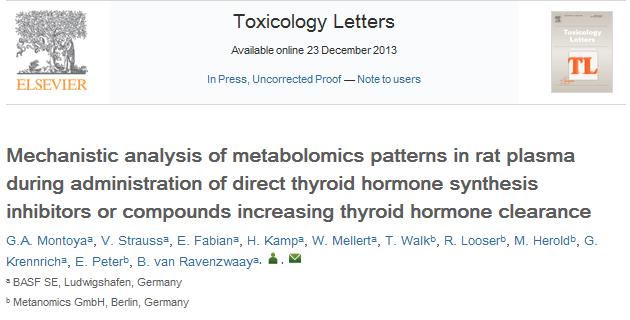This new paper reports investigations into exactly what thyroid-related effects various substances had - some of which are known to suppress thyroid function, others which affect the rate of clearance of thyroid hormones.
Two warnings:
The full paper is not available. A great pity as we only have the slightest glimpse of what it is about. Worth following the second link if you are interested.
This research was done by BASF or its subsidiaries so commercially sensitivities might have affected what has been reported and, indded, what they were looking for!
Toxicol Lett. 2013 Dec 23. pii: S0378-4274(13)01466-5. doi: 10.1016/j.toxlet.2013.12.010. [Epub ahead of print]
Mechanistic analysis of metabolomics patterns in rat plasma during administration of direct thyroid hormone synthesis inhibitors or compounds increasing thyroid hormone clearance.
Montoya GA, Strauss V, Fabian E, Kamp H, Mellert W, Walk T, Looser R, Herold M, Krennrich G, Peter E, van Ravenzwaay B.
Abstract
For identification of toxicological modes of action (MOAs) a database (MetaMap®Tox) was established containing plasma metabolome consisting of approximately 300 endogenous metabolites. Each five male and female Wistar rats per groups were treated with>500 reference compounds over a period of 28 days. More than 120 specific toxicity patterns of common metabolite changes associated with unique MOAs were established. To establish patterns predictive effects on the thyroid, animals have been treated with reference compounds directly acting on the thyroid hormone formation (such as methimazole, ethylenethiourea) as well as liver enzyme inducers leading to an increased excretion of thyroid hormones and therewith to a secondary response of the thyroid (such as aroclor 1254 and boscalid). Here we present the plasma metabolite changes which form the patterns for direct and indirect effects on the thyroid. It is possible to identify metabolites which are commonly regulated irrespective of an indirect or direct effect on the thyroid as well as groups of metabolites separating both MOAs. By putting the metabolite regulations in the context of affected pathways helps to identify thyroid hormone inhibiting MOAs even when the hormone levels are not consistently changed. E.g., direct thyroid hormone synthesis inhibitors affect some enzymes in the urea cycle, increase the ω-oxidation of fatty acids and decrease glutamate and oxoproline levels, whereas indirect thyroid hormone inhibiting compounds interact with the lipid mediated and liver metabolism.
Copyright © 2013. Published by Elsevier Ireland Ltd.
KEYWORDS:
Biomarker, Metabolomics, Mode of action, Pattern, Thyroid, Toxicity
PMID:
24370789
ncbi.nlm.nih.gov/pubmed/243...
A little more is visible here:
sciencedirect.com/science/a...
Rod


